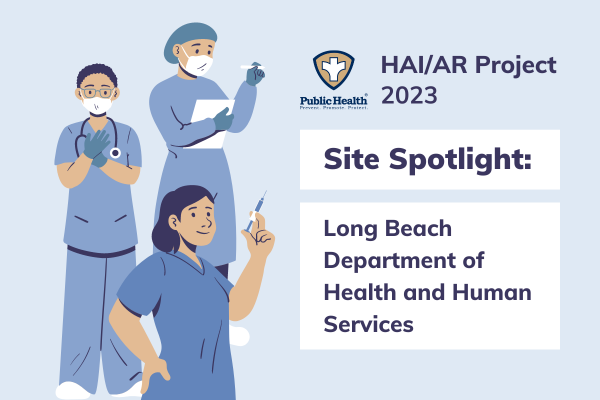The National Association of County and City Health Officials (NACCHO), the voice of the country’s nearly 3,000 local health departments, with support from the Centers for Disease Control and Prevention (CDC), Division of Healthcare Quality and Promotion, awarded eleven local health departments with funding to support the Local Health Department Healthcare-Associated Infections and Antimicrobial Resistance (HAI/AR) project. These funds supported their ability to pilot and implement the CDC (Interim) Local Health Department Strategy for HAI/AR.
HAIs are among the leading causes of preventable deaths in the United States. The CDC estimates that one in 31 hospital patients are infected with at least one HAI, and AR is a major public health threat that compounds the challenge of HAIs. Antimicrobial-resistant infections cause more than 35,000 deaths each year, and nine of the top 18 infections considered to be the highest AR threats are often associated with healthcare settings.
The selected local health departments used the CDC (Interim) Local Health Department Strategy for HAI/AR to enhance the capacity of HAI/AR prevention and response, including through conducting infection control assessments, strengthening antimicrobial stewardship efforts, improving laboratory coordination, and enhancing HAI/AR data reporting and access. They also coordinated with stakeholders at the local and state levels to advance these efforts.
We asked our HAI/AR pilot project sites to reflect on their experiences and lessons learned since joining our project. Here is what one of our sites, Long Beach Department of Health and Human Services, shared with us. A standalone version of their blog post can be found here.
Long Beach Department of Health and Human Services Healthcare-Associated Infections / Antimicrobial Resistance Program Implementation
“Healthcare-Associated Infections (HAI) are infections that patients acquire while receiving treatment for other conditions in long-term care and other healthcare settings. HAIs poses a threat to our most vulnerable populations. The Long Beach Department of Health and Human Services (LB DHHS) Healthcare Associated Infection (HAI) program works diligently to prevent, surveil, and respond to HAI and antimicrobial resistant (AR) pathogens in health care facilities in Long Beach.
Since the program’s inception in August of 2021, the LB DHHS HAI program has expanded its capacity and implemented tools to improve infection prevention and control in long-term care and other healthcare settings. The HAI program at Long Beach assists with COVID-19, multidrug-resistant organisms (MDRO), and other HAI outbreaks. With support from the NACCHO Infectious Disease HAI/AR Demonstration site project, the LB DHHS HAI program has created several pathways to prevent and respond to various HAI/AR related events. Activities included strengthening agency partnership, developing a new reporting system for long-term care facilities in Long Beach, distributing educational resources, and more.”
Agency Partnership
“The LB DHHS HAI program has built partnerships with state, local, and community agencies in efforts to compile best practices for HAI prevention. HAI prevention and response requires a coordinated effort across several agencies. Reasons for such inter-agency collaboration include extensive patient sharing networks, screening and testing requirements for diagnosis and limiting prevention, identifying patient care history across LHDs, and the need for healthcare facility guidance and cooperation. One step LB DHHS HAI program has taken to better understand and collaborate with partner agencies was to map out the agencies that the program collaborates with, indicators for collaboration, as well as shared goals and values.
Identified partner agencies have included the California Department of Public Health (CDPH), federal agencies including Centers for Disease Control and Prevention (CDC) and U.S. Food and Drug Administration (FDA), surrounding health jurisdictions and those with frequent patient sharing, regulatory agencies, advisory committees, local laboratories, state and federal laboratories and health care and professional organizations. Mapping such partnerships has allowed our program to understand and visualize the larger picture of the coordinated efforts in HAI prevention and response.”
California Department of Public Health
“Collaboration with the California Department of Public Health (CDPH) has been a crucial component in ensuring our program has had the knowledge and resources to begin HAI/AR work locally and to continue to expand our programmatic work. The CDPH HAI Program has provided our program with HAI investigation and outbreak guidance quick sheets on specific organisms to guide our activities, hosted several educational trainings on various HAI topics, as well as posting many other materials on their website that have been used for reference and training tools in educating our skilled nursing facilities and hospitals. The CDPH HAI Program has also directed useful projects directed toward the improvement of best practices in high-risk facilities including Project Firstline and the Ventilator Skilled Nursing Facility (vSNF) Workgroup.
The HAI Infection Preventionist (IP) Program and the partner IPs under this program have provided technical assistance in establishing onset assessments at health care facilities under our local jurisdiction. The regional IPs continue to assist our program with recommendations of HAI prevention and response activities or consultation on specific outbreaks. The regional HAI IP program provides non-regulatory assistance and topic expertise that has been critical in developing our programs hands-on educational activities and mitigating complex or novel outbreaks.”
Infection Preventionists
“As a smaller health jurisdiction, one strength of our program is our relationship with our healthcare facilities’ infection preventionists. As an approach to build rapport, in our program we assign each of our facilities to a designated point of contact at our program. This allows the IP and HAI investigator to develop a personal relationship. Using this strategy, the IP will know exactly who to contact when they have a question, and they feel more comfortable reaching out for assistance when needed. This allows our program to provide guidance and strategies to the facility before there is anything to report.
During the pilot project, our program has focused on developing resources to assist in our collaboration including an LB DHHS HAI webpage that the IPs and other healthcare personnel can reference for local guidance related to HAI/AR. Additionally, the HAI program has begun to send a monthly newsletter to provide relevant updates and highlight best practices.”
REDCap Project
“To organize efforts in HAI reporting, the LB DHHS HAI program has initiated a project on REDCap. REDCap is a free, secure, browser-based application to support data collection. The HAI REDCap project is designed to allow facilities to report various diseases and outbreaks, including individual case reporting via online REDCap surveys. The platform will replace handwritten and digital Confidential Morbidity Reports (CMR). The adoption of this system to the HAI program will help in providing accurate and consistent reporting that in the past had the potential to be lost in fax or email trails. While the HAI program continues to work on improving project capacity limitations, there were many notable lessons learned during the development of the portal.
Epidemiologists working on the development of this project faced significant challenges when designing this project to fit the needs of the HAI program. The aim of the project was to be able to have a single platform that can be used to streamline HAI reports while also being used for case and outbreak management. Due to unfamiliarity with the REDCap platform, the first notable undertaking of this project was to learn the REDCap platform and to understand its capabilities and limitations. Under the time constraints of this pilot, we also simultaneously were working to draft each of the project’s surveys. As new platform limitations were discovered, this required us to rework the structure and question format of our surveys. This resulted in several iterations of this project. Another noteworthy barrier of this project was creating questions that were clear, concise, and free of interpretation and thus could achieve the most accurate documentation. However, despite the initial challenges, REDCap will serve to improve the program’s data collection strategy, storage, and reporting.”
Staff Development
“To provide useful and clinically relevant guidance to our healthcare facilities, our HAI program staff needs to stay abreast of the latest HAI/AR updates and information. One significant undertaking of this pilot project has been to organize and prepare our program staff to become CIC certified. The CIC examination is a standardized measure of infection prevention and control knowledge, skills, and abilities expected of working professionals in the field. The CIC exam has provided the program staff members taking the exam to develop their knowledge specific to infections, best practices and epidemiology related to HAI. The CIC will allow our program staff to provide more complete on-site assessments and better guidance related to infection prevention and control. In addition to the CIC, the LB DHHS HAI program staff stay informed of HAI/AR updates through participation in local and regional HAI/AR collaborative groups, reviewing and utilizing resources from advisory groups and reputable sources including CORHA and CDC.”
Final Thoughts
“The Centers for Disease Control and Prevention (CDC), HAI/AR Strategy has provided guidance for the LB DHHS HAI program to streamline various activities and strengthen programmatic work in the prevention and response of nosocomial infections. The majority of the implemented activities selected for this project period are categorized as level 2, which were built off of previous level 1 foundations. The CDC HAI/AR Strategy served as a guide to build internal capacity for increasing HAI/AR needs in Long Beach. In addition, utilizing the strategy has helped expand and build close partnerships with various local, state, and federal agencies. The LB DHHS HAI program has made notable advances in the past few months, while implementing the CDC HAI/AR LHD Strategy. Efforts to continue to strengthen our HAI/AR capabilities and response remain a priority to improve the overall safety and health quality in the City of Long Beach.”



